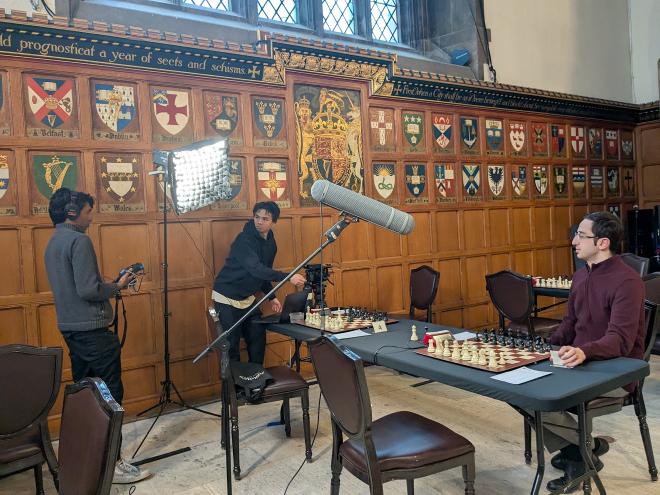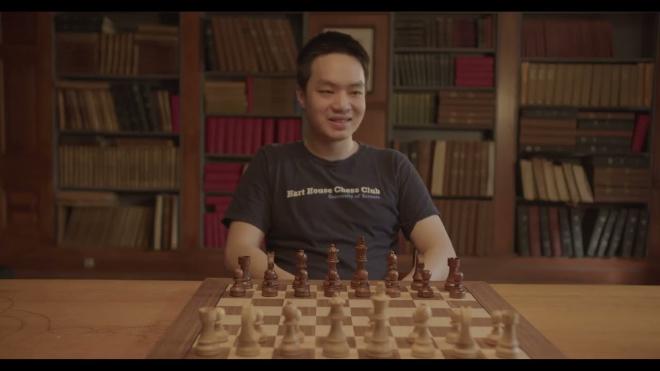Lessons Learned in Producing Chess Videos

Table of Contents
As Secretary/Chair of the Hart House Chess Club, I was uniquely positioned to think about where our funding and goals should be directed each year. One of our primary goals has always been expanding chess’s reach to new audiences. Another is to preserve memories, help future organizers, and document chess history.
On the media front, we explored several mediums to communicate our ideas to audiences. We successfully secured press coverage for our events and activities, including getting the Globe and Mail to write a piece about our work reigniting chess at U of T post-pandemic. We built an extensive photo collection and history archive available on Facebook here. We also produced numerous videos on our YouTube which have been viewed thousands of times.
One of the main initiatives I spearheaded as Secretary was developing both long-form and short-form videos. I believe the next generation of chess players and future University of Toronto students will turn to YouTube more than our website to learn about chess activities.
During my time on the Executive, we experimented with and produced over 20 videos in different formats, including:
- Commentator videos (commenting on games featuring master-level commentators) - see FM Koosha Jaferian’s content.
- Event recap videos both without voiceover (recapping events such as the 2023 Ivy League Challenge) and with voiceover
- Short-form videos with minimal editing, such as those on our Facebook page here
- Interview-style videos such as this series on YouTube on organizer and arbiters at chess events
- YouTube Live streams such as a match between two UToronto International Masters
- Longer narrative recaps with voiceover such as the one we created for the National Championship
- YouTube videos targeting specific topics like “Why Play In-Person Chess” along with full-length companion videos
I think a large portion of the inspiration that we got was from the Charlotte Chess Center and St Louis Chess Club who have some very compelling content.
My Role in Video Production #
As an Executive of the Club, my role was less about actually holding cameras or conducting interviews during shoots.
For the most part, I focused on ensuring that videographers and photographers had everything they needed. We worked to ensure they had support for their work, answered their questions, and provided on-site support. Before the shoots I would figure out financial information and take requests for proposals. I would also engage with prospective videographers to find the right fit for the Club’s interests.
Another challenge was that for many of these tournaments, I served as Tournament Director, so my focus was primarily on running the tournament rather than overseeing the video production. In retrospect, I think organizers should delegate dedicated people to manage media activities so that focus can be dedicated to these efforts.
What Does It Mean to Be a Producer? #
I ended up serving as the producer for most of the videos we have published on YouTube. It’s less about the technical filmmaking aspects and more about getting the final product into the hands of audiences. While I couldn’t tell you what camera we were using (just that it was top-notch), that doesn’t mean I didn’t observe and learn from how videographers work and operate.
 |
|---|
| Behind the scenes on one of our projects |
What I Learned from Directors and Videomakers #
Here are the key insights I gained from working with video professionals:
They value clear goals One mistake I made was sometimes having overly broad goals for video projects. It would have been better to sit down extensively with videographers before shoots to discuss our projects in greater depth. This would have aligned the end product more closely with everyone’s expectations. The creative vision can be difficult to convey through text alone.
Limit to one videographer or media person at a time. For chess events, it’s beneficial to have videographers work during different rounds when possible. This allows us to give them our full attention and support.
Editing is the most time-consuming part. Editing is significantly more challenging and time-intensive than shooting. I discovered that people spend extensive time editing photos and videos. Capturing footage can be quick; editing takes much longer.
Quality comes at a price. Filmmaking is an incredibly challenging business, and I didn’t initially realize how much we needed to invest to get quality results. I’ve never been an filmmaker but I hear that it’s tough to break into the industry and tough to finance projects.
Experienced professionals are hard to find. The most effective way for potential collaborators to reach us was through direct email. We didn’t have extensive word-of-mouth networks to find experienced videographers. When we did hear from folks, videographers with a portfolio were prioritized by us.
Hart House has excellent resources. The Film Board and Camera Club provided immense help and support. The people we contracted from these organizations were high-quality professionals. It’s wonderful to support fellow Hart House clubs and U of T students.
Final Thoughts #
I firmly believe short-form videos represent the future of content creation. I do think chess communities and chess organization is missing a large portion of possible chess players who don’t even know that there are chess activities going on.
We have several final projects planned leading up to the 2026 Canadian University Chess Championships, which will include more video initiatives.
Videography is an art form, and those working in the industry deserve recognition and celebration. With emerging technologies like Veo creating increasingly sophisticated AI-generated videos, the work of human videographers will become even more challenging and at the same time even more valuable. They should be supported and celebrated as much as possible.
 |
|---|
| An interview I had in 2024 discussing the 2024 Canadian Zonals |